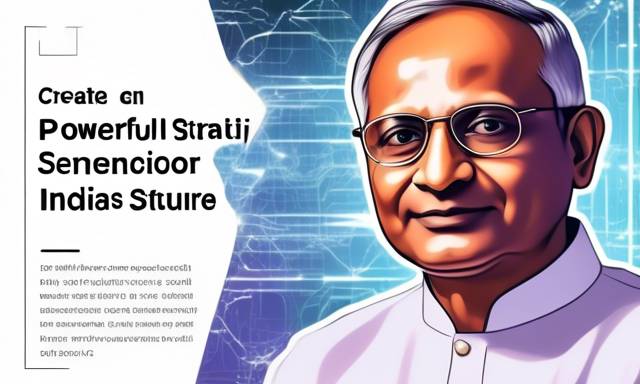How India’s Semiconductor Ambitions Could Transform the Crypto Market
Hey there! It’s super exciting to dive into the topic of semiconductors, especially since they play such a vital role in the tech world, including the crypto market. Did you know that the semiconductor industry in India is on the verge of a major breakthrough? And guess what—this breakthrough could have significant implications for the crypto market!
Key Takeaways
- India’s semiconductor sector is evolving, aiming for self-sufficiency and global competitiveness.
- The focus on building local companies versus relying solely on multinational corporations can reshape job creation and innovation.
- Semiconductor availability and innovation are crucial for blockchain technology and cryptocurrency growth.
- Collaboration between MSMEs and global players can enhance India’s position in the semiconductor market.
So, let’s get into the nitty-gritty of why this matters for all of us potential investors, especially those of us keen on the booming crypto scene.
The Landscape of India’s Semiconductor Industry
India has embarked on its second phase of the semiconductor policy, known as Semicon 2.0. The first phase laid the groundwork, showing us the potential of the market and attracting a wave of investments. Now, this next phase is all about execution. It’s like being in a race; the first lap was good, but now it’s time to push ourselves to the finish line.
Imagine in the next few years, if India can establish at least two semiconductor companies among the global top 10. That’s huge! It means that we could finally achieve self-sufficiency in critical areas like communications, power, and even defense. For us in the crypto space, self-sufficiency in technology means reduced reliance on foreign technologies, which often affect performance and costs.
Choices Ahead: Models of Development
India has a couple of paths it can take in terms of developing its semiconductor industry. One option is to support multinational companies that already dominate the market. Yes, this can be effective, and it’s kind of like how India has excelled in IT by servicing global companies. But what about the local players?
The alternative model, which I personally think fits our culture beautifully, is the Taiwan model. Here, local Micro, Small & Medium Enterprises (MSMEs) play a significant role. We can empower them, creating a robust ecosystem that not only strengthens the semiconductor industry but also boosts job creation. More jobs mean more innovation, which is essential for fields like blockchain and cryptocurrencies.
Why This Matters for Crypto
Alright, let’s connect the dots here. Have you ever considered how much we rely on semiconductors for our crypto devices, mining rigs, and wallets? These little chips are like the unsung heroes behind the scenes. The more capable and innovative our semiconductor industry, the better our chances of developing advanced technologies for the crypto market.
When innovations happen within India, it means that we could potentially have local access to cutting-edge technologies, allowing faster transactions and potentially lower costs. Think about it—having chips designed and manufactured right here in India would mean faster response times, less environmental impact from shipping, and opportunities for local startups to innovate.
The Power of Collaboration
But here’s the kicker: while the government’s initiative is vital, collaboration is key. We need compelling partnerships that bring together the strengths of MSMEs and larger global players. Instead of pouring billions into established companies that may not prioritize local interests, why not invest in our local talent? It’s like tapping into a goldmine of creativity and innovation.
Additionally, with the demand for software engineers skyrocketing, India has a significant advantage. NASSCOM (the tech industry trade association) will be crucial in shaping this Indian model. With software expertise onboard, we can optimize semiconductor functionalities, enhancing our capabilities in blockchain development and generating an even stronger ecosystem for cryptocurrencies.
A Personal Insight and Practical Tips
From my perspective as a crypto analyst and an enthusiastic investor, it’s important to keep an eye on this evolving semiconductor landscape. Here are some practical tips for anyone looking to dip their toes into this space:
-
Stay Updated: Follow the developments in India’s semiconductor policies and investments. Understanding how these changes affect both the technology and Crypto markets will help you make informed decisions.
-
Invest in Blockchain Startups: Look out for companies that are leveraging cutting-edge semiconductor tech to enhance their blockchain solutions. These can be the future game changers!
-
Be Part of Communities: Engage in forums or meetups focused on crypto and technology. Connecting with like-minded individuals can uncover opportunities you might not have considered.
- Diversify: Don’t put all your eggs in one basket. The crypto market is volatile, and so is the semiconductor industry. A portfolio that reflects a mix of both can be beneficial.
Moving Forward
As we wrap up our chat, just think about this—what role do you think local innovations in semiconductors will play in the future of cryptocurrencies? The blend of these sectors could redefine opportunities and outcomes for investors like us!
I genuinely believe that if India navigates its semiconductor journey wisely, we could be at the forefront of a tech revolution that not only propels our economy but also enriches the global crypto landscape. Let’s be excited about this journey ahead!





 By
By
 By
By
 By
By
 By
By

 By
By